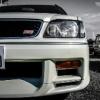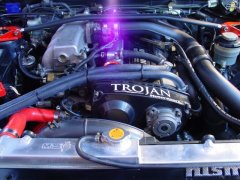Announcements
-
Similar Content
-
Latest Posts
-
Right. I'll try my best at a concise "bring you up to speed" on stuff that may be missing here - obviously open to questions or further input from others as relevant. Here's a datalog from a responsive turbo setup with electronic boost control being used a bit, to keep it simple I've marked 3 points of interest. All of these charts are on the same time scale on the X-axis, so you can reference what engine rpm is doing in the top graph, boost and EMAP (exhaust backpressure) in the second graph, and turbo rpm in the bottom graph. A) The turbo gets it's power from exhaust gas, and pumping air takes work. As a result you can't just spin a turbo with a fixed amount of exhaust energy and expect it to keep spooling - the bigger the turbo (ie, the more air it can push) the more exhaust energy you need to drive it. The most obvious ways of getting more exhaust energy are by adding displacement, adding boost, or adding rpm - but as you add any of these the turbo also needs to do a bit more work so there is a big balance of these things needed to even get to your target boost and sometimes that's not even possible. What you can see in step "A" is that there isn't enough engine rpm or boost to reach the level we want, so this is where "lag" is. The dyno run continues and rpm increases, which gives enough energy to increase boost, which helps spool the turbine speed up even more - so you can see that the rate that the boost (and turbo speed) are starting to ramp up faster than the engine rpm is, so turbo is really starting to wake up as the graph gets closer to point B.... B) At this point we've been able to reach the boost that is actually desired at this point. To stop the boost from going further than this the wastegate will open and bypass gas past the turbine, meaning it doesn't continue accelerating at the point it was before but instead carry on at a more progressive rate which matches what the engine needs. The wastegate will have a spring in it which is rated to a specific pressure where it will start bypassing, but electronic boost control (managed by the ECU) can adjust how much pressure the spring sees in order to allow some tunability on how much boost the wastegate actually sees, and therefore how much exhaust it bypasses. The tune in this case stops boost from ramping up HARD at around 21-22psi just before 4000rpm, then as the rpm continue it allows boost to continue up to around 25psi higher in the rpm. You can see the turbo speed fairly steadily increases through the rpm to ensure it's keeping up with the increasing airflow demand due to the engine speed being higher and boost being pretty steady. If the boost dropped off after a point then you may see the turbo speed level off or even drop. C) You can see that despite the boost pressure staying pretty flat here, the exhaust pressure is steadily increasing and at this stage has overtaken boost pressure. This isn't unusual, and is largely as a result of the increasing energy needed by the turbo to pump more and more air to suit the needs of the engine as it revs out further. There are a bunch of variables in regards to how much back pressure there will be on a given turbo etc, but its one of the factors we manage when sizing and tuning a turbo setup. When exhaust back pressure starts exceeding boost pressure you will eventually start seeing signs that the turbo is running out, the engine gets less keen to make more power and it gets harder to raise boost further. In this case it's a fairly acceptable compromise for the power level (around 630kw on a 3litre engine with full boost by 4000rpm), but you'd not want to push it a lot harder than this. The maximum speed rated for the compressor wheel on this setup is around 125,000rpm so you can see its starting to get close on that side as well - I feel like this kind of illustrates some of the turbo related things we both decide on how far to push, and are also limited to how far we can push depending on the parts combination. Hope this helps more than it confuses things
-
For that influx of Spammers we had I made no pic posting and no PM's for first ten posts. This is group based and I've manually updated @Beanie to the Members group which will open up the images and PM's.
-
Thx for the reassuring reply. I’ve got above legal clearance going in for roadworthy Friday… fingers crossed it’s keeping me awake bloody nanny state
-
I was actually going to try and dig out a datalog with turbine speed and EMAP haha
-
Wait until @Lithium posts a compressor map and tries to explain what's going on. There is a strong possibility that the OP lives in a digital world and is not comfortable with analogue machines. A turbo is just about as analogue as it gets, with plenty of non-linear behaviours added in on top. Most of us who think we know how they work are actually only getting by on 2nd and 3rd order mental models that abstract away from the actual physics and bring it back to the sort of kindergarten level concepts we can hold in our heads. This is important when you need to hold 10 such concepts in your head at the same time. You need to reduce the complexity of the individual concepts to allow them to be simultaneously held and manipulated. Too much complexity in the base models makes it very difficult to make them work with each other mentally.
-







Recommended Posts
Create an account or sign in to comment
You need to be a member in order to leave a comment
Create an account
Sign up for a new account in our community. It's easy!
Register a new accountSign in
Already have an account? Sign in here.
Sign In Now